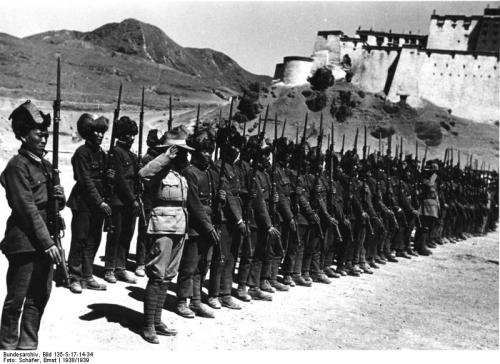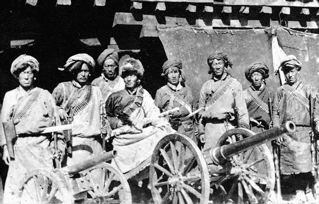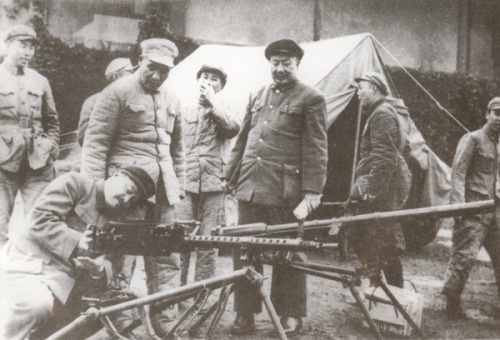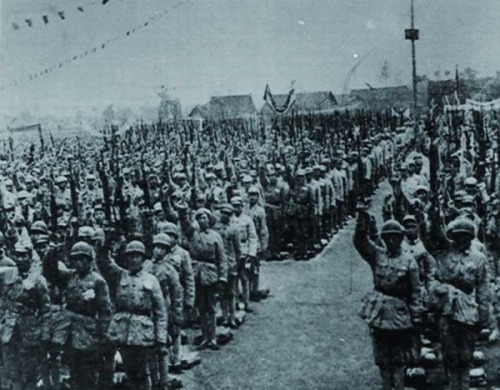peashooter85:The Chinese Invasion of Tibet and the Battle of ChambdoThroughout most of it’s ancient
peashooter85:The Chinese Invasion of Tibet and the Battle of ChambdoThroughout most of it’s ancient history, Tibet had been either controlled by China or was a protectorate of China. In 1903 Tibet became de facto independent after the fall of the Qing Dynasty. Life in Tibet had changed little over the centuries, and even though the countries around it were entering the modern world, it was still a very medieval society and government. Nor was it proper to consider it united country. The Tibetan government had little power, and its influence expanded no farther than a few small city centers. Most of the country was tribal in nature, governed by small villages and communities headed by tribal or village elders. Much of the country was controlled by bandits, warlords, and marauders. The nation was very insular and isolated, not just by geography, but the culture of the people, which was very suspicious of foreigners, and the Tibetan government, which limited the number of foreigners permitted in the country. Tibet was also behind the time in terms of technology. There were no cars, no trains and airplanes, little electricity and plumbing, and very basic and crude infrastructure. Finally, it was hard to call Tibet itself a united country. The tribes and regions of Tibet were fiercly independent, and often resented government authority, both foreign and domestic. Tibetans of the Kham region and Lhasan Tibetans were often suspicious and hateful to each other. When the Communist under Mao took control of China, the new Chinese Government began to pressure Tibet to once again assume the role of subordinate to China. In negotiations, China demanded that it be permitted to station troops in Tibet, that Tibet become a semi-autonomous region of China, and that China control Tibet’s trade and foreign policy. The Tibetan’s refused of course, which led to further strained relations between the two countries. On the night of October 6th/7th, 40,000 men of the People’s Liberation Army crossed the border and invaded the Kham region, conducting an aggressive offensive directed towards the city of Chamdo, the primary citadel of the Tibetan Army. The Tibetan Army was not prepared to fend off an invasion. They had few men and few modern weapons. In the 1930′s Tibet had attempted to modernize the military, hiring British and Indian military advisers while purchasing 7,260 Lee Enfield rifles, 1,800 Bren machine guns, 168 sten guns, and around 100 mortars. These new arms were not enough to fully equip the Tibetan Army, and many soldiers still were armed with antique matchlock muskets and bows. The Tibetan Army had little heavy artillery, much of which consist of old cannon from an earlier age. Finally, the Tibetan Army had little combat experience, amounting to infrequent skirmishes with Chinese troops, warlords, and marauders. By contrast the People’s Liberation Army was well equipped with seemingly infinite amounts of rifles, submachine guns, machine guns, mortars, artillery, airplanes, and vehicles. More importantly, the PLA had been involved in constant combat against Chinese nationalist forces, Chinese warlords, and the Japanese Army. It was well equipped, battle hardened, and motivated to win.The war lasted less than two weeks. The disunity of the Tibetan people helped bring about the downfall of Tibet, as the Kham people initially did nothing to resist the invasion, seeing it as an opportunity to become independent. The well equipped and mobile PLA quickly outmaneuvered the Tibetan Army, surrounding and annihilating it at Chamdo. After a short battle which led to the deaths of 180 Tibetan soldiers, the Tibetan Army quickly melted away into nothing, with 3,000 captured and the rest deserting. The Chinese then quickly occupied the country.After the invasion, the Chinese treated the Tibetans well. They never attacked civilians, released all prisoners as soon as the war ended, and were hospitable to the the public. Early on, many of the reforms China enacted were beneficial to Tibet and its people. The Chinese introduced new technology, infrastructure, and expended Tibetan infrastructure. The Tibetan Government was given a great deal of autonomy, however the Chinese removed many corrupt, overprivlidged, abusive, and tyrannical officials. Many reforms were instituted that improved Tibetan society and improved human rights. However, Tibet’s honeymoon with Chinese occupation went sour by the later 1950′s as China then sought to radically change Tibetan society along the lines of Maoist ideals. This lead to open revolt among the Tibetan people, both peaceful and violent. The Tibetan government was dissolved and the Dalai Lama forced into exile. Tens of thousands were murdered, thousands more were imprisoned and tortured, and hundreds of Buddhist monasteries were destroyed in the ensuing crackdown. Today, Chinese brutality is still common in Tibet, with Tibetans tortured and imprisoned for simply practicing their religion and culture. -- source link
Tumblr Blog : peashooter85.tumblr.com



